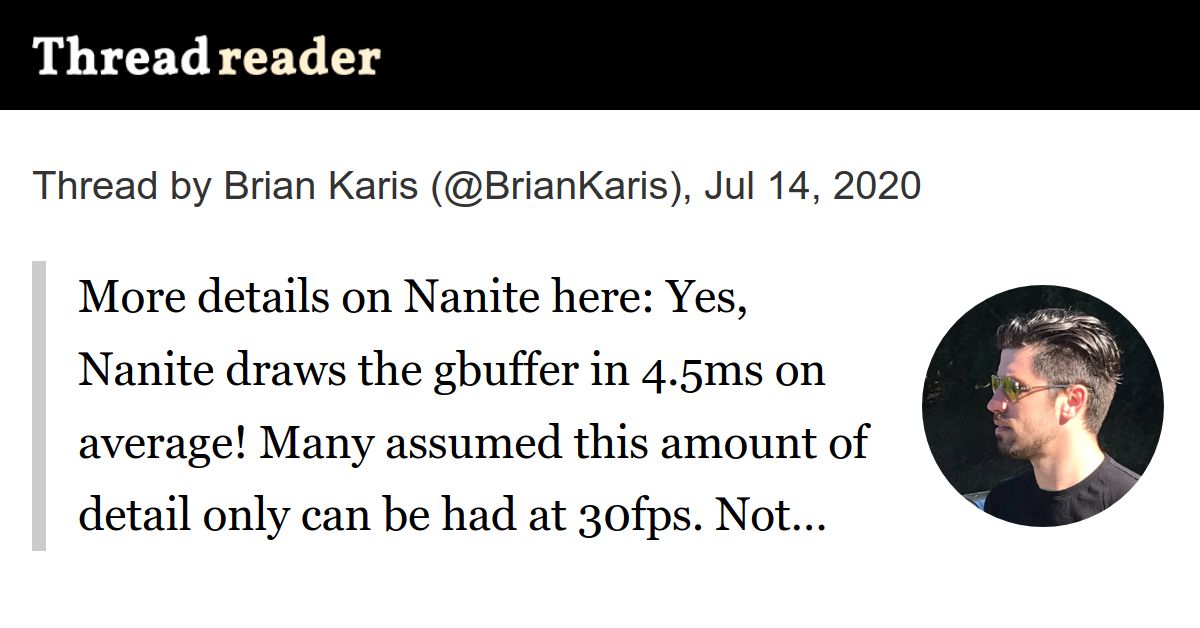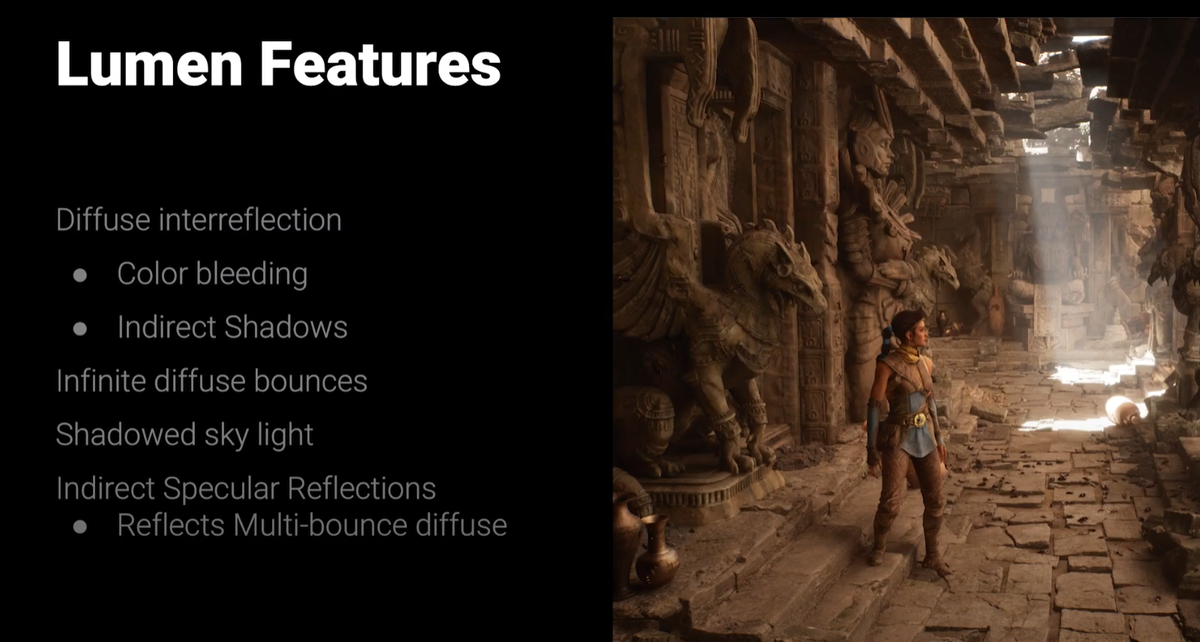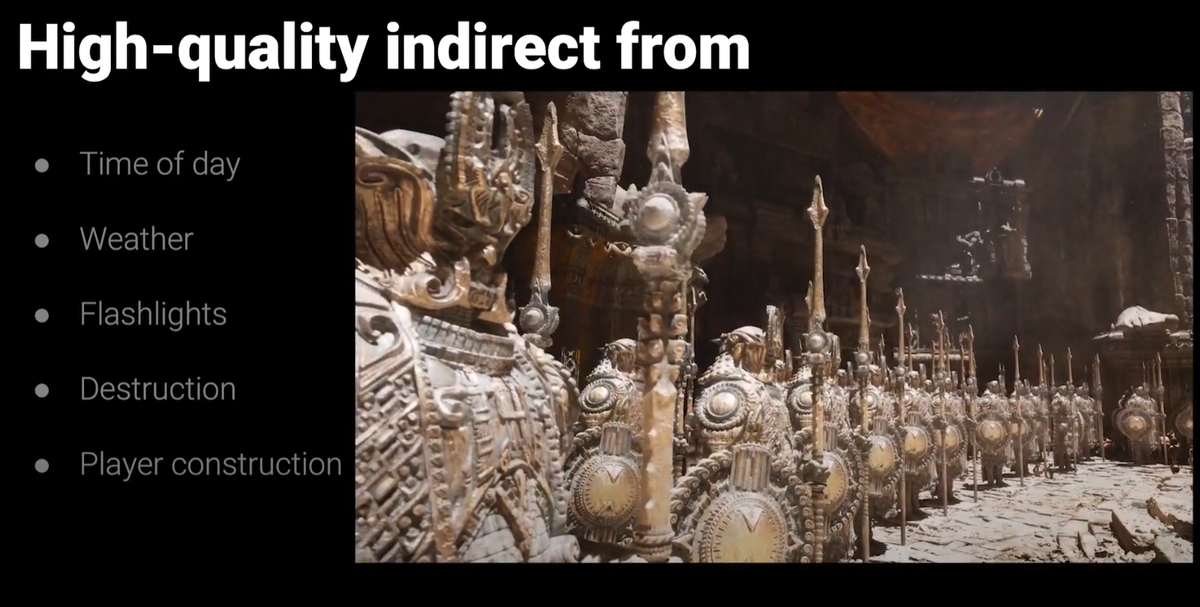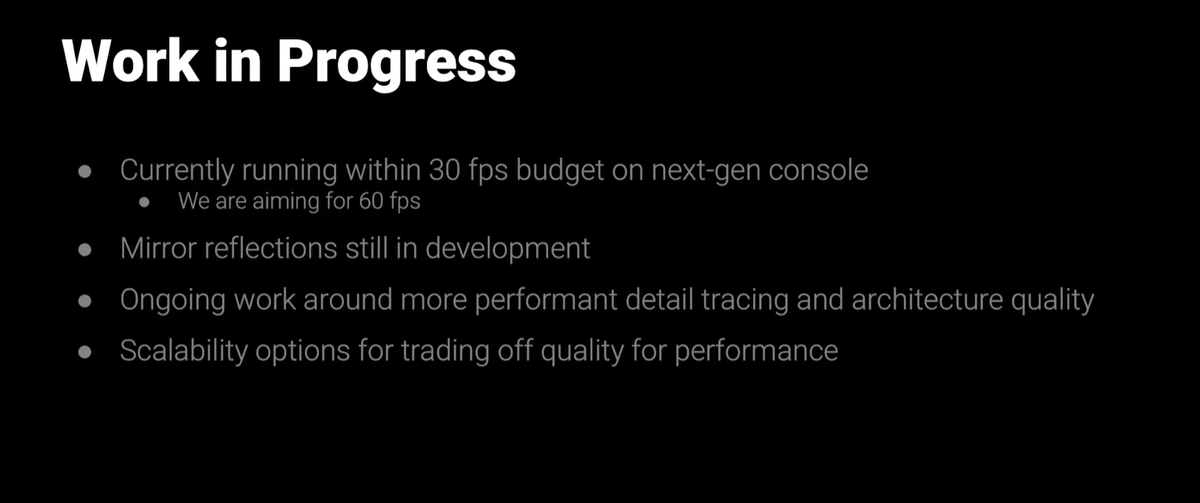-
Ever wanted an RSS feed of all your favorite gaming news sites? Go check out our new Gaming Headlines feed! Read more about it here.
-
We have made minor adjustments to how the search bar works on ResetEra. You can read about the changes here.
Unreal Engine for Next-Gen Games | Unreal Fest Online 2020
- Thread starter Sklaary
- Start date
You are using an out of date browser. It may not display this or other websites correctly.
You should upgrade or use an alternative browser.
You should upgrade or use an alternative browser.
Looking forward to it. Appreciate the link.
Oh the promises the future may hold with quixel integration, nanite LoD system and ray marching lumen system.
Oh the promises the future may hold with quixel integration, nanite LoD system and ray marching lumen system.
Looking forward to it. Appreciate the link.
Oh the promises the future may hold with quixel integration, nanite LoD system and ray marching lumen system.
"The Last of Us" for PS5.
haha. my first though was Naughty Dog PS5 exclusive in 2025
Dev talk. Not that much for us. Maybe som cool engine demos.
Thanks!
for those asking, the description in the youtube video says
In this presentation, Nick Penwarden, VP of Engineering, and Marcus Wassmer, Engineering Director, cover the features in Unreal Engine that will be crucial to the success of developing the next generation of games, and reveal innovative features being developed that will revolutionize game development. Then, Jerome Platteaux, Art Director, provides an in-depth look at how Epic created the "Lumen in the Land of Nanite" UE5 demo. This presentation is part of Unreal Fest Online 2020. Learn more and register to view all presentations at
Dang, I shouldn't be up right now, and this making me want to stay. I had no idea this was happening, but looking forward to seeing some cool new info on UE5.
Some bits:
- Nanite takes about 4.5ms to render the gbuffer. This is 'within budget' for the geometry costs in a 60fps game.
- Lumen is why this demo was 30fps - targeting 60fps for release.
- The streaming buffer for the demo was 768MB.
- The flying scene had hundreds of thousands of objects
No other deep technical details on how nanite works, or scales. Their art director will talk about how the demo was made, so maybe there might be a but more stuff there, though I expect it'll be art-orientated.
- Nanite takes about 4.5ms to render the gbuffer. This is 'within budget' for the geometry costs in a 60fps game.
- Lumen is why this demo was 30fps - targeting 60fps for release.
- The streaming buffer for the demo was 768MB.
- The flying scene had hundreds of thousands of objects
No other deep technical details on how nanite works, or scales. Their art director will talk about how the demo was made, so maybe there might be a but more stuff there, though I expect it'll be art-orientated.
Yep, me too
768MB? thats it??Some bits:
- Nanite takes about 4.5ms to render the gbuffer. This is 'within budget' for a 60fps game.
- Lumen is why this demo was 30fps - targetting 60fps for release.
- The streaming buffer for the demo was 768MB.
- The flying scene had hundreds of thousands of objects
No other deep technical details on how nanite works, or scales. Their art director will talk about how the demo was made, so maybe there might be a but more stuff there, though I expect it'll be art-orientated.
Which one of these from KZSF's vram usage is the streaming buffer?

768MB? thats it??
Which one of these from KZSF's vram usage is the streaming buffer?

The 572 segment - though be wary of making direct comparisons, that number will vary across games/scenes, and available streaming bandwidth/latency etc on different hardware.
It does suggest very aggressive and efficient streaming though, given the data fidelity jump.
What would have been nice to have from the UE5 presentation would be the equivalent to the 1.6GB number there.. i.e. I guess, how much data was streamed through ultimately in the demo.
so that flying section shouldnt exactly need a super fast ssd feeding it data really fast? then can always just increase the pool of streaming data to account for any deficiencies in the SSD read speeds?The 572 segment - though be wary of making direct comparisons, that number will vary across games/scenes, and available streaming bandwidth/latency etc on different hardware.
It does suggest very aggressive and efficient streaming though, given the data fidelity jump.
so that flying section shouldnt exactly need a super fast ssd feeding it data really fast? then can always just increase the pool of streaming data to account for any deficiencies in the SSD read speeds?
Ultimately you can always use RAM to compensate yeah. This is all ultimately memory management. The million dollar question is how much RAM you'd need next to a given streaming capacity, or how that scales, which is all a bit opaque at the moment.
They also mentioned the average resolution, but it differs slightly from their original information in terms of specificity. Less than 1440p on average: 2496X1404. Which is intense.Some bits:
- Nanite takes about 4.5ms to render the gbuffer. This is 'within budget' for the geometry costs in a 60fps game.
- Lumen is why this demo was 30fps - targeting 60fps for release.
- The streaming buffer for the demo was 768MB.
- The flying scene had hundreds of thousands of objects
No other deep technical details on how nanite works, or scales. Their art director will talk about how the demo was made, so maybe there might be a but more stuff there, though I expect it'll be art-orientated.
I really am not sure how they will scale lumen up or down come release, that should be interesting to see. 60hz target at the same resolution could mean some interesting compromises. Also to see how they will deal with mirrors or light leaking at all, which an SDF, screenspace, voxel hybrid they have should be replete with.
So after all that, in fact bandwidth wasn't the bottleneck that a lot of people imagined it was. Just fancy that!
Looking forward to it. Appreciate the link.
Oh the promises the future may hold with quixel integration, nanite LoD system and ray marching lumen system.
Last of Us Part III looks crazy.
It's pretty cool that it can handle so many objects that you don't have to worry about bundling assets together or even merging meshes... which may help with dynamism of scenes, and things like destruction.
What he's talking about and showing just there might give you some further insight on some of those things. They showed bits of the demo in-editor on PC there too.
What are you referring to? I think we still don't know anything specific about that. There was zero insight into the demo's peak streaming throughput there as far as I could see.
They also mentioned the average resolution, but it differs slightly from their original information in terms of specificity. Less than 1440p on average: 2496X1404. Which is intense.
I really am not sure how they will scale lumen up or down come release, that should be interesting to see. 60hz target at the same resolution could mean some interesting compromises. Also to see how they will deal with mirrors or light leaking at all, which an SDF, screenspace, voxel hybrid they have should be replete with.
What he's talking about and showing just there might give you some further insight on some of those things. They showed bits of the demo in-editor on PC there too.
So after all that, in fact bandwidth wasn't the bottleneck that a lot of people imagined it was. Just fancy that!
What are you referring to? I think we still don't know anything specific about that. There was zero insight into the demo's peak streaming throughput there as far as I could see.
Because they stated that Lumen was the reason it was at 30fps.What are you referring to? I think we still don't know anything specific about that. There was zero insight into the demo's peak streaming throughput there as far as I could see.
It could also be exactly the other way around. You only need such a small streaming buffer ("dead space" in the RAM needed for the assets streaming in and therefore you have more usable RAM for other stuff) BECAUSE the IO is so damn fast.So after all that, in fact bandwidth wasn't the bottleneck that a lot of people imagined it was. Just fancy that!
However, as already mentioned, we unfortunatelly don't know anything specific...
They also mentioned the average resolution, but it differs slightly from their original information in terms of specificity. Less than 1440p on average: 2496X1404. Which is intense.
I really am not sure how they will scale lumen up or down come release, that should be interesting to see. 60hz target at the same resolution could mean some interesting compromises. Also to see how they will deal with mirrors or light leaking at all, which an SDF, screenspace, voxel hybrid they have should be replete with.
Is it safe to assume after that presentation the rumors or leaks or whatever you want to call it about the laptop running the demo was pretty much the truth?
Because they stated that Lumen was the reason it was at 30fps.
That's the GPU draw bottleneck on frametime.
It has nothing to do with how much data the demo is accessing or would like to access for ideal results.
The GPU is rarely ever going to actually stall a frame for data (i.e. data becoming a bound for that reason) - some level of detail is likely always kept in memory, or a very conservative window of minimum LoD kept. Data access becoming a bound on the quality of data available to draw at a given point is a different matter, and that's the question people have been asking about and theorising about.
What excites me the most is the guiding principle they are taking with UE5, which is to optimize the workflow.
Easier, more straightforward pipeline thanks to fancy new tech + new hardware is so exciting.
Easier, more straightforward pipeline thanks to fancy new tech + new hardware is so exciting.
Correct me if I'm wrong, but shouldn't the streaming buffer this coming gen become smaller, EXACTLY BECAUSE OF the SSDs in the next gen consoles?
Because the SSDs are now so fast, the need for a big streaming buffer, like the 1,6GB one example a couple of posts above, are now redundant?
I think Mark Cerny also talked about this in the technical video, where the streaming buffer in the memory is now way smaller because they can now fetch/dumb data from the SSD to RAM way faster and don't have to preload a lot of stuff into the RAM because of the slow HDDs.
So I guess the 768MB streaming buffer makes sense?
Because the SSDs are now so fast, the need for a big streaming buffer, like the 1,6GB one example a couple of posts above, are now redundant?
I think Mark Cerny also talked about this in the technical video, where the streaming buffer in the memory is now way smaller because they can now fetch/dumb data from the SSD to RAM way faster and don't have to preload a lot of stuff into the RAM because of the slow HDDs.
So I guess the 768MB streaming buffer makes sense?
The most important things missing from the video is the size of the demo on the disk and the give examples of asset size. The only indication was a 1 millions triangle geometry asset is equivalent to a 4k texture.
Correct me if I'm wrong, but shouldn't the streaming buffer this coming gen become smaller, EXACTLY BECAUSE OF the SSDs in the next gen consoles?
Because the SSDs are now so fast, the need for a big streaming buffer, like the 1,6GB one example a couple of posts above, are now redundant?
I think Mark Cerny also talked about this in the technical video, where the streaming buffer in the memory is now way smaller because they can now fetch/dumb data from the SSD to RAM way faster and don't have to preload a lot of stuff into the RAM because of the slow HDDs.
So I guess the 768MB streaming buffer makes sense?
The logic makes sense, the final number is just unexpectedly low. Which is amazing.
However, that pool is for the current demo. Through in dynamic elements such as enemies, physics objects etc, and then expect that pool to go up.
Very interesting video! Gave new insights into the game dev world. Nanite and especially lumen looks amazing!
Yeah, if I remember correctly Cerny talked about going from needing the coming 30 seconds in RAM to 1-2 now. That's at least a 15x reduction in data size for the same assets. Of course nextgen means that asset size will increase, but with a big buffer to occupy the same amount of RAM as current gen games.Correct me if I'm wrong, but shouldn't the streaming buffer this coming gen become smaller, EXACTLY BECAUSE OF the SSDs in the next gen consoles?
Because the SSDs are now so fast, the need for a big streaming buffer, like the 1,6GB one example a couple of posts above, are now redundant?
I think Mark Cerny also talked about this in the technical video, where the streaming buffer in the memory is now way smaller because they can now fetch/dumb data from the SSD to RAM way faster and don't have to preload a lot of stuff into the RAM because of the slow HDDs.
So I guess the 768MB streaming buffer makes sense?
21.00 did they just confirm SENUA is rendered in CG? and not realtime
21.00 did they just confirm SENUA is rendered in CG? and not realtime
I think they referred to all those examples as realtime.
21.00 did they just confirm SENUA is rendered in CG? and not realtime
Mentioned it as real time I think.
21.00 did they just confirm SENUA is rendered in CG? and not realtime
Yeah, they mentioned that as real time.
Knowing that it's gonna be easy to move from UE4 to UE5 is great news.
That flying section already run fine with regular NVMe SSD on a gaming laptop, so I would say no.so that flying section shouldnt exactly need a super fast ssd feeding it data really fast?
Too bad there isn't some rudimentary close captioned system. These sessions are designed such that the lectures won't overlap but the Q and A portions will overlap. I can only focus on one session at a time. But this talk on audio development has been illuminating and worth my time.
This is my main concern regarding Lumen. It's supposed to be faster / more efficient than RT, yet it seems pretty computationally expensive itself.They also mentioned the average resolution, but it differs slightly from their original information in terms of specificity. Less than 1440p on average: 2496X1404. Which is intense.
I really am not sure how they will scale lumen up or down come release, that should be interesting to see. 60hz target at the same resolution could mean some interesting compromises. Also to see how they will deal with mirrors or light leaking at all, which an SDF, screenspace, voxel hybrid they have should be replete with.
While this is genrally the case I think this upcoming lecture might interest someone like you.
Unreal Engine for Next-Gen Games
Tuesday, July 14, 2020
01:00 p.m. - 01:45 p.m.
In this presentation, Nick Penwarden, VP of Engineering, and Marcus Wassmer, Engineering Director, will cover the features in Unreal Engine that will be crucial to the success of developing the next generation of games and reveal innovative features being developed that will revolutionize game development.
Then, Jerome Platteaux, Art Director, will provide an in-depth look at how Epic created the Lumen in the Land of Nanite UE5 demo.
Great for: all existing and potential users of Unreal Engine

Thread by @BrianKaris: More details on Nanite here: Yes, Nanite draws the gbuffer in 4.5ms on average! Many assumed this amount of detail only can be had at 30fps.…
Thread by @BrianKaris: More details on Nanite here: Yes, Nanite draws the gbuffer in 4.5ms on average! Many assumed this amount of detail onlhad at 30fps. Not true! This is well within typical 60hz budgets. That doesn’t even count optimizations I’ve made…
Brian Karis talk about Nanite interesting and it shows some of the data are too big of a demo because of size on the SSD
Last edited:








